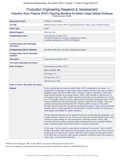JavaScript is disabled for your browser. Some features of this site may not work without it.
| dc.contributor.author | Jourdain, Renaud | |
| dc.contributor.author | Castelli, Marco | |
| dc.contributor.author | Shore, Paul | |
| dc.contributor.author | Sommer, P. | |
| dc.contributor.author | Proscia, David | |
| dc.date.accessioned | 2016-09-01T14:33:31Z | |
| dc.date.available | 2016-09-01T14:33:31Z | |
| dc.date.issued | 2013-04-11 | |
| dc.identifier.citation | Jourdain, R. et al. (2013) Reactive Atom Plasma (RAP) figuring machine for meter class optical surfaces, Vol. 7, Iss. 6, pp. 665-670 | en_UK |
| dc.identifier.issn | 0944-6524 | |
| dc.identifier.uri | http://dx.doi.org/10.1007/s11740-013-0467-1 | |
| dc.identifier.uri | https://dspace.lib.cranfield.ac.uk/handle/1826/10481 | |
| dc.description.abstract | A new surface figuring machine called Helios 1200 is presented in this paper. It is designed for the figuring of meter sized optical surfaces with form accuracy correction capability better than 20 nm rms within a reduced number of iterations. Unlike other large figuring facilities using energy beams, Helios 1200 operates a plasma torch at atmospheric pressure, offers a high material removal rate, and a relatively low running cost. This facility is ideal to process large optical components, lightweight optics, silicon based and difficult to machine materials, aspheric, and free form surfaces. Also, the surfaces processed by the reactive atom plasma (RAP) are easy to fine polish through hand conventional sub-aperture polishing techniques. These unique combined features lead to a new capability for the fabrication of optical components opening up novel design possibilities for optical engineers. The key technical features of this large RAP machine are fast figuring capabilities, non-contact material removal tool, the use of a near Gaussian footprint energy beam, and a proven tool path strategy for the management of the heat transfer. Helios 1200 complies with the European machine safety standard and can be used with different types of reactive gases using either fluorine or chlorine compounds. In this paper, first the need for large optical component is discussed. Then, the RAP facility is described: radio frequency R.F generator, plasma torch, and 3 axis computer numerically controlled motion system. Both the machine design and the performance of the RAP tool is assessed under specific production conditions and in the context of meter class mirror and lens fabrication. | en_UK |
| dc.language.iso | en | en_UK |
| dc.publisher | Springer | en_UK |
| dc.rights | Attribution-Non-Commercial-No Derivatives 3.0 Unported (CC BY-NC-ND 3.0). You are free to: Share — copy and redistribute the material in any medium or format. The licensor cannot revoke these freedoms as long as you follow the license terms. Under the following terms: Attribution — You must give appropriate credit, provide a link to the license, and indicate if changes were made. You may do so in any reasonable manner, but not in any way that suggests the licensor endorses you or your use. Information: Non-Commercial — You may not use the material for commercial purposes. No Derivatives — If you remix, transform, or build upon the material, you may not distribute the modified material. No additional restrictions — You may not apply legal terms or technological measures that legally restrict others from doing anything the license permits. | en_UK |
| dc.rights | The final publication is available at Springer via http://dx.doi.org/10.1007/s11740-013-0467-1 | en_UK |
| dc.subject | RAP | en_UK |
| dc.subject | Figuring | en_UK |
| dc.subject | Plasma etching | en_UK |
| dc.subject | Optical fabrication | en_UK |
| dc.subject | Plasma machining | en_UK |
| dc.subject | Inductively coupled plasma | en_UK |
| dc.title | Reactive Atom Plasma (RAP) figuring machine for meter class optical surfaces | en_UK |
| dc.type | Article | en_UK |
Files in this item
This item appears in the following Collection(s)
-
Staff publications (SATM) [4367]
